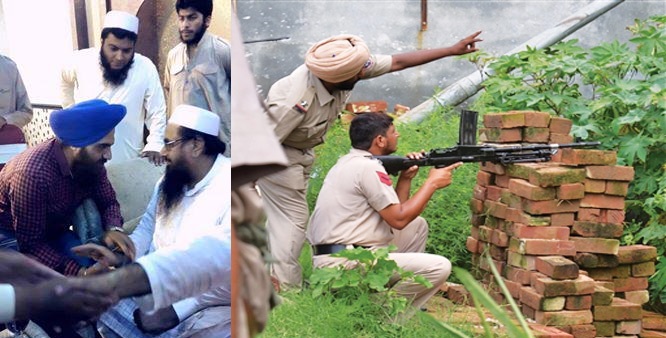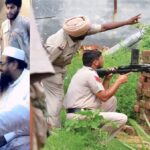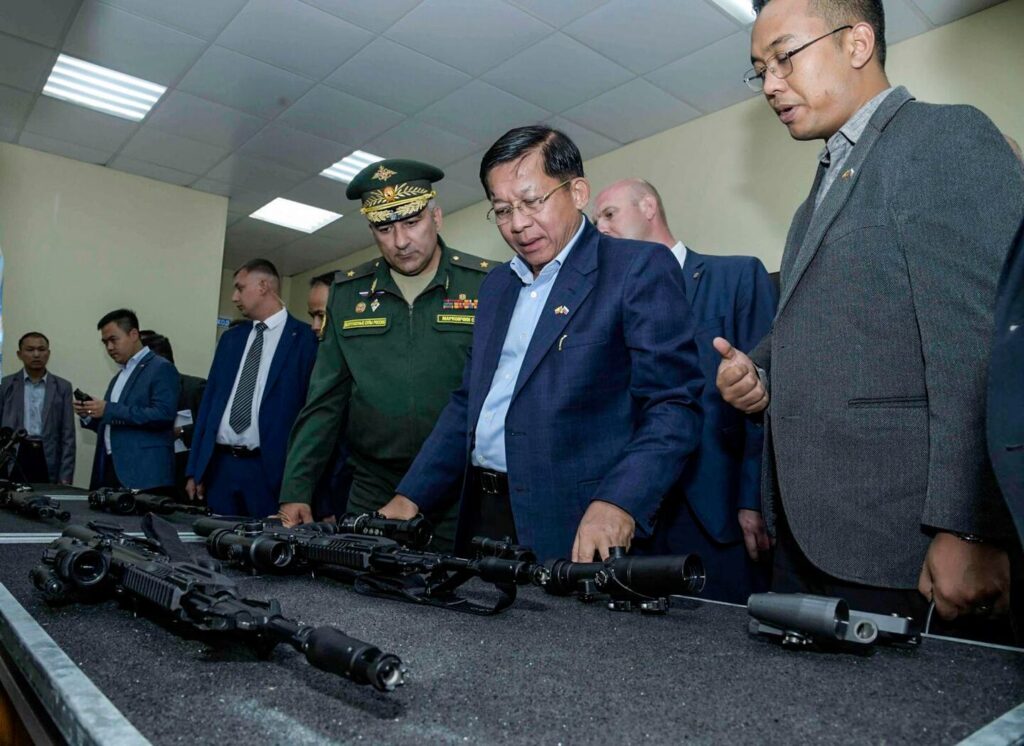MANTRAYA ANALYSIS#04: 29 JULY 2015
BIBHU PRASAD ROUTRAY & SURYA VALLIAPPAN KRISHNA
Abstract
The terror attack in Gurdaspur on 27 July 2015 points to an expanded game plan by the terror outfits and their sponsors in Pakistan. A bloody Punjab fits well into the Lashkar-e-Toiba (LeT)’s objective of an engorged war with India beyond the traditional theatre of Kashmir. For the Inter-Services Intelligence (ISI) opening up the Punjab conflict yet again is a much-cherished dream. Given that the attack failed attempts to repeat the adventure might be on the anvil.

Source- Twitter & Jagran.com
A July 2015 photograph of Sardar Gopal Singh Chawla, general secretary of Pakistan Sikh Gurdwara Parbandhak Committee (PSGPC) clasping the hand of Lashkar-e-Toiba (LeT) chief Muhammad Hafiz Saeed appeared more like a desperate plea for assistance rather than a friendly handshake between two collaborators. Nevertheless, taken less than two weeks before the 27 July 2015 terrorist attack in Gurdaspur in Punjab, the snap came for much scrutiny on social media. While the identities of the killed terrorists originating from Pakistan and involved in the attack that lasted half a day, are still unknown, the choice of Punjab as a target could have been the culmination of several objectives ranging from expanding the theatre of Jihad to reviving the Khalistan movement.
Chawla is a rabid anti-India campaigner and an ardent protagonist of the Khalistan movement. Not only the PSGPC celebrates birthday of slain Sikh extremist leader Jarnail Singh Bhindranwale every year, Chawla’s posts on social media makes no attempt to hide his admiration for terrorists like Hafiz Saeed. Posting his photograph with Saeed, Chawla wrote in mid-July 2015, “Hafiz Saeed kae saath khubsurat lamhae, dushman ka dushman dost, khalistan zindabad, Indian zalam sarkar murdabad“. (Beautiful moments with Hafiz Saeed, Enemy’s enemy is a friend, long live Khalistan, Death to oppressive Indian government.) The project of reviving the Khalistan movement, dead in India but flickering in some countries including Pakistan, runs much deeper than Chawla’s public demonstration of intimacy with Hafiz Saeed.
Between 2012 and 2014, Gurmeet Singh alias Jagtar Singh Tara, leader of the Khalistan Tiger Force (KTF) held at least three meetings with Asdullah Maulvi, an LeT commander in Pakistan. In these meetings, both men deliberated on the intricacies of delivering arms and RDX into Punjab to revive the ‘dead and gone’ Sikh militancy. Tara expressed his inability to find enough foot soldiers to carry out ‘operations’ in Punjab. Maulavi, reportedly based in Sialkot and in contact with the Inter-Services Intelligence (ISI) of Pakistan, volunteered to send his own trained fidayeen cadres along with the hardware into the Indian state.
The LeT was keen on repeating the delivery of an RDX consignment after a similar attempt failed in 2011. On 12 October that year an Indica car with RDX had been intercepted at Ambala in Haryana while on its way from Jammu. The consignment was meant for carrying out a major explosion in national capital New Delhi on the Diwali day few days later. The KTF, on that occasion, had claimed responsibility for the incident.
Tara, an accused in the 1995 bomb blast that killed Punjab Chief Minister Beant Singh, had remained a guest of the ISI in Pakistan after escaping from Chandigarh’s high security Burail jail in January 2004. The project of reviving militancy in Punjab included six LeT cadres who coordinated with Tara and the entire group functioned under an ISI official of Lieutenant colonel-rank known only by his surname “Chaudhary”. In October 2014, Chaudhury asked Tara to move to Thailand to liaison with other Sikh militants who were turning up in that country from European destinations. Tara entered Thailand on a Pakistani passport and was kept in the house of a Pakistani national at Chonburi, in eastern Thailand, about 100 kilometres southeast of Bangkok. However, Tara’s luck ran out in few months. He was arrested in a joint operation of Punjab Police and the Royal Thai Police and was extradited to India on 16 January 2015. Tara was the fourth high profile Khalistani terrorist with deep nexus with the ISI and the LeT to have fallen into the hands of the Indian authorities in less than four months.
On 17 September 2014, Rattandeep Singh, the chief of the Bhindranwale Tiger Force of Khalistan (BTFK) was arrested from Gorakhpur in Uttar Pradesh. Rattandeep was based in Pakistan since 1993 and is linked to Paramjit Singh Panjwar, who is now a builder in Pakistan and Ranjit Singh Neeta, head of Khalistan Zindabad Force (KZF). On 6 November 2014, Ramandeep Singh Goldy, head of the KTF was arrested at the Chennai airport after the Malaysian authorities handed him over to India. Based in Thailand, Goldy was arrested by Malaysian police after he fled Thailand, where he was based since 2011 using the assumed name of Sah Brahmdev and a forged Nepali passport. Goldy had set up an export-import firm named Euro 2014 Private Limited in Bangkok, which provided a cover for his pro-Khalistani activities. Goldy remained in touch with Khalistani terrorists in Pakistan, North America and Europe and was providing logistical support to Khalistani terrorists in Southeast Asia.
A day later, on 7 November 2014, Harminder Singh alias Mintoo, chief of the Khalistan Liberation Force (KLF) and his associate Gurpreet Singh Gopi were picked up at the Indira Gandhi International Airport after their extradition from Thailand. Based in Pakistan between June 2013-May 2014 and working under the same Lieutenant colonel Chaudhary, Mintoo was tasked with undertaking an extensive European tour with the intent to strengthen the KLF. Before reaching Thailand, where the ISI ran a terror camp at Mae Sot, on the Thai-Myanmar border, Mintoo sought cadres and funds in Italy, Belgium, Germany and France.
Five Sikhs based in United Kingdom including Gursharanvir Singh, a resident of Coventry of England and Piyara Singh Gill, a Birmingham resident also wanted by Punjab Police in August 2009 killing of Rulda Singh, President of Rashtriya Swayamsevak Sangh (RSS) affiliate Rashtriya Sikh Sangat), are known to have attended the camp at Mae Sot. Extradition requests of Gursharanvir and Piyara Singh are lying with the British authorities. The Mae Sot camp imparted training on assembling and handling of explosives made from locally available material. The ISI, unlike the LeT is no longer confident of being able to move RDX into India.
In the camp, the cadres, especially the Indian nationals, were also asked to develop sleeper cells in their respective areas. Among those who attended the camp was Ramandeep Singh alias Sunny of Bathinda who was picked up by the Bathinda police on 9 November 2014 after he returned to India. Explosive material and a revolver were recovered from Sunny. Intricate information of the Mae Sot camp, the first ever camp be have been organsied by the ISI outside Pakistan, following the arrests severely dented the agency’s future plans of organising similar camps in Thailand. Indian intelligence sources believe that about two dozen Khalistani terrorists in Pakistan (including Paramjit Singh Panjwar, Ranjeet Singh Neeta and Bhindranwale’s nephew Lakhbir Singh Rode) have been advised to coordinate their activities from within Pakistan, without taking the risk of moving into countries like Thailand and Malaysia with whom India enjoys excellent counter-terrorism cooperation.
At one level, these arrests are continuing successes for the Punjab police in dismantling the Khalistani terror network. On the other hand, Tara, Mintoo and Goldy are integral part of a still alive project to revive terrorism in Punjab through the well organised collaboration by the state as well as non-state entities in Pakistan. While a bloody Punjab fits well into the LeT’s objective of an engorged war with India beyond the traditional theatre of Kashmir, for the ISI opening up the Punjab conflict yet again is a much cherished dream.
Much of the objective of the ‘Reignite Khalistan’ project, at least till 2013, veered around the game plan of targeted assassination of Hindu leaders and prominent personalities of other sects in Punjab. In 2013, the Punjab police neutralised various modules and sleeper cells created by Mintoo. However, the attack in Gurdaspur- targeting the police station and also the trains- point at an expanded game plan. Given that the attack failed- not being able to inflict high casualty and failing to escalate into a hostage taking situation- attempts to repeat the adventure might be on the anvil. The terrorists and their handlers in Pakistan will have no obligation to confine their targets to the geographical boundary of Punjab.
(Dr. Bibhu Prasad Routray is the Director of MISS. Surya Valliappan Krishna is a Research Intern at MISS. All Mantraya publications are peer-reviewed.)




